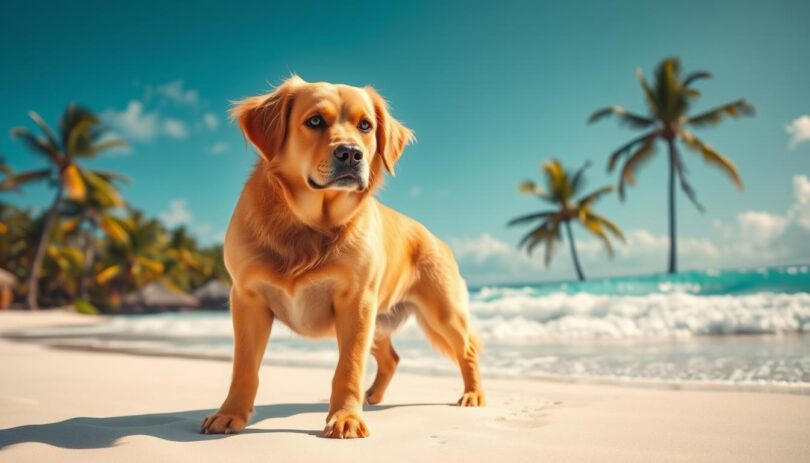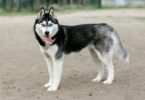Imagine walking along a sunlit Caribbean beach when a scruffy, grinning pup trots up to you. Its wiry coat glimmers in the light, and its tail wags with uncontainable joy. This isn’t just any stray—it’s a coconut retriever, a free-spirited companion shaped by island life and cherished by locals.
These mixed-breed dogs thrive in warm climates, blending resilience with playful charm. Known as “Creoles” in some regions, they’ve earned their nickname through generations of adapting to coastal environments. Their wiry fur, lean build, and expressive eyes reflect a heritage built for exploration.
Students and families living near beaches often share stories of these strays becoming loyal friends. One tale describes a pup that followed a group home from school daily, eventually becoming their guardian. Another recounts a dog that learned to crack fallen coconuts—a skill passed down through local packs.
Today, coconut retrievers captivate pet lovers beyond their native islands. Their rugged appearance and adaptable nature make them intriguing candidates for adoption. As you explore their traits, you’ll discover why these dogs embody the spirit of tropical communities—and how they’re winning hearts worldwide.
Exploring the Unique Features of the Coconut Retriever
Caribbean coastlines have shaped more than landscapes—they’ve molded a canine companion unlike any other. These spirited animals combine rugged durability with a social nature, thriving in environments where sand meets sea.
Key Breed Traits and Distinct Features
Their wiry, salt-resistant coats protect against tropical elements, while lean muscles enable agile movements across uneven terrain. Temperament varies, but most display curiosity and loyalty—traits honed through generations of coastal survival. Unlike traditional retrievers, these mixes often exhibit problem-solving skills, like opening fallen coconuts or navigating rocky shores.
Insights From Caribbean Roots
Local communities play a vital role in shaping these animals. Veterinary students at Caribbean universities frequently document how strays adapt to island ecosystems. One group observed puppies learning tidal patterns to hunt crabs—a behavior passed through generations.
Adoption stories reveal their adaptability. Families report seamless transitions when bringing these dogs home, noting their affinity for water activities and warm climates. Their heritage fosters resilience, making them ideal companions for active households seeking low-maintenance pets.
How Does a coconut retriever look like?
Spotting these coastal canines reveals nature’s ingenuity. Their wiry, medium-length coats range from sandy tan to sun-bleached brown, often with lighter underbellies. Tight curls or loose waves provide heat resistance, while lean muscles support agile movements across rocky shores.
Signature Appearance: Coat, Colors, and Build
Built for endurance, their compact frames typically stand 18-22 inches tall. Paws feature thick pads for traversing hot terrain, and almond-shaped eyes stay alert to surroundings. The low-maintenance fur sheds sand easily—a practical trait honed through generations.
Comparisons With Other Dog Breeds
Unlike bulkier retrievers, these dogs often weigh 35-50 pounds—ideal for quick coastal dashes. Their energy levels surpass Labradors but remain manageable compared to high-strung terriers. Temperamentally, they blend a retriever’s loyalty with a stray’s self-reliance.
One family adopting a scruffy puppy from Barbados shared how its wiry coat softened indoors within months. Veterinary students documented similar transformations, noting how puppies develop thicker fur in colder climates after transitioning to home life.
Cultural Impact and Rescue Stories from the Island
When Dr. Meredith Berger first encountered Susie, a scruffy island stray, she saw more than a wandering dog. This moment sparked a decade-long mission bridging Caribbean communities with U.S. adoption networks. Today, countless dogs find homes through programs like Penelope’s Rescue Mission, transforming lives on both sides of the ocean.
Tales of Strays Turned Family Members
Susie’s journey from scavenging beachside trash to becoming a therapy animal in Florida captures these transformations. Families adopting island dogs often describe “lightbulb moments” when their new friend grasps indoor routines. One couple shared how their rescue learned to signal bathroom needs by pawing at windows—a behavior developed within weeks of home life.
The Role of Veterinary Care and Adoption Programs
Organizations like The Susie Project highlight the power of spay/neuter initiatives. Veterinary teams work alongside islanders to control stray populations humanely. Foster networks prepare dogs for adoption through socialization and basic training. These efforts reduce overcrowding while preserving each animal’s spirited personality.
Experiences From the Caribbean and U.S. Transitions
Cultural differences shape rescue work. While many Caribbean households keep dogs outdoors, U.S. adopters prioritize indoor family bonds. Rescue groups bridge this gap through education campaigns. Transport logistics involve health checks and climate-adjusted travel crates—ensuring safe journeys from tropical shores to suburban homes.
Final Thoughts on the Coconut Retriever Legacy
The journey of island-born canines from beach wanderers to beloved companions encapsulates a legacy of resilience. Over the years, communities and rescue organizations have transformed countless lives—both human and canine. A Ross University veterinary student shared how fostering two puppies, Alpine and Sienna, revealed their quick adaptability to home life, proving even spirited strays thrive with care.
Families describe these animals as loyal friends who guard homes with quiet devotion. Stories of rescued puppies pawing at windows to signal needs highlight their intelligence and desire to connect. Veterinary professionals emphasize that every adopted dog carries cultural history, blending survival instincts with affectionate traits.
Their enduring impact lies in bridging worlds—tropical origins meeting modern households. By choosing to foster or adopt, individuals honor this heritage while giving spirited pups fresh opportunities. As symbols of perseverance, they remind us that love often arrives on four paws, ready to redefine what it means to belong.
FAQ
What makes this breed distinct from other retrievers?
These dogs blend athletic builds with water-resistant coats, ideal for tropical climates. Their medium size and agile frame help them navigate island terrains, while their expressive eyes and tawny fur shades reflect their Caribbean heritage.
Are they suitable for families with young children?
Yes! Their gentle temperament and loyalty make them excellent companions. Many adoptive families report they bond closely with kids, though supervision is recommended during playtime due to their energetic nature.
How do adoption programs help these dogs find homes?
Rescue organizations partner with Caribbean veterinarians to provide health screenings before arranging foster care or international adoptions. Programs often involve volunteers, including students studying animal welfare, to prepare puppies for life in U.S. households.










Leave a Comment